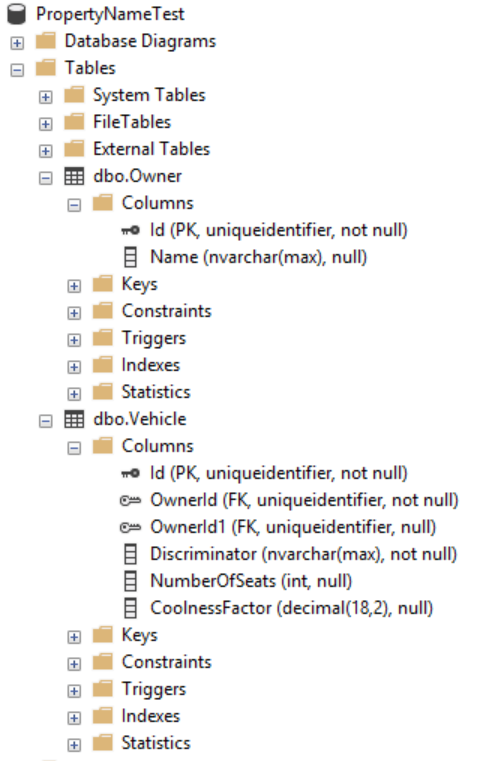Why is EF Core adding 1 to my column names?
11 Jun 2018Today I came across a really annoying issue which practically wiped out my whole day! >.<
I was undertaking an ambitious project whereby I’d map some pre-existing SQL tables to a new set of domain classes when I came across the following error…
at System.Data.SqlClient.SqlCommand.<>c.<ExecuteDbDataReaderAsync>b__180_0(Task`1 result)
at System.Threading.Tasks.ContinuationResultTaskFromResultTask`2.InnerInvoke()
at System.Threading.Tasks.Task.Execute()
For some context the domain classes I wrote were abstract with navigation properties on both the abstract classes, as well as the derrived classes.
To save your sanity I have recreated a very basic similar set of classes for your eye balls.
public class Car : Vehicle
{
public int NumberOfSeats { get; set; }
}
public class Motorbike : Vehicle
{
public decimal CoolnessFactor { get; set; }
}
public abstract class Vehicle
{
public Guid Id { get; set; }
public Guid OwnerId { get; set; }
public Owner Owner { get; set; }
}
public class Owner
{
public Guid Id { get; set; }
public string Name { get; set; }
}And the following is how the above classes were incorrectly configured.
public class VehicleContext : DbContext
{
private const string ConnectionString = @"Server=(localdb)\mssqllocaldb;Database=PropertyNameTest;Trusted_Connection=True;MultipleActiveResultSets=true";
private static DbContextOptions Options => new DbContextOptionsBuilder<VehicleContext>()
.UseSqlServer(ConnectionString)
.Options;
public VehicleContext()
: base(Options)
{
}
protected override void OnModelCreating(ModelBuilder modelBuilder)
{
modelBuilder.Entity<Vehicle>(vehicle =>
{
vehicle.HasKey(x => x.Id);
vehicle.HasOne<Owner>()
.WithMany()
.HasForeignKey(x => x.OwnerId);
vehicle.HasDiscriminator()
.HasValue<Car>("CAR")
.HasValue<Motorbike>("BIKE");
});
modelBuilder.Entity<Owner>(owner =>
{
owner.HasKey(x => x.Id);
});
}
}So just to be clear this is what the SQL table would look if you were to allow Entity Framework to deploy the above domain model.

I never created a property called OwnerId1?!
I tried all the seemingly obvious things.
I added explicit column name fluent mappings. Nothing.
I added a reverse navigation property. Nothing.
So how do we fix this happy little miracle?
Well it turned out to be such a simple fix. The problem was with how my DbContext had been configured.
vehicle.HasOne<Owner>(x => x.Owner)
.WithMany()
.HasForeignKey(x => x.OwnerId);facepalm.gif
In fact digging into the EntityTypeBuilder source code explicity outlines this case.
Summary:
Configures a relationship where this entity type has a reference that points to a single instance of the other type in the relationship.
Note that calling this method with no parameters will explicitly configure this side of the relationship to use no navigation property, even if such a property exists on the entity type. If the navigation property is to be used, then it must be specified.
I’m not 100% sure why the navigation expression defaults to null but hey ho.
— Dan
